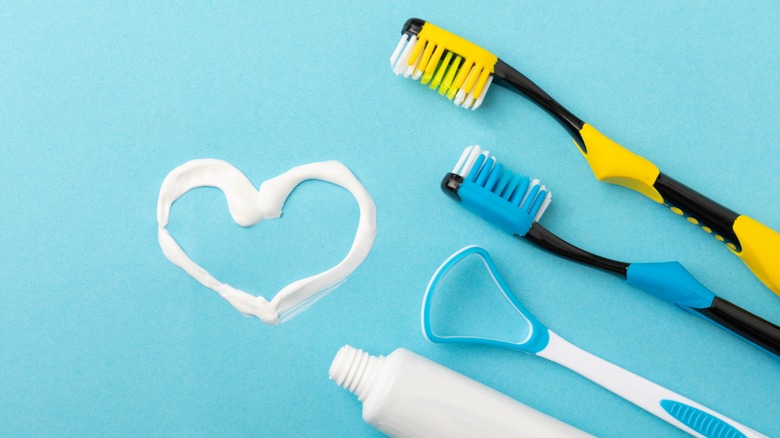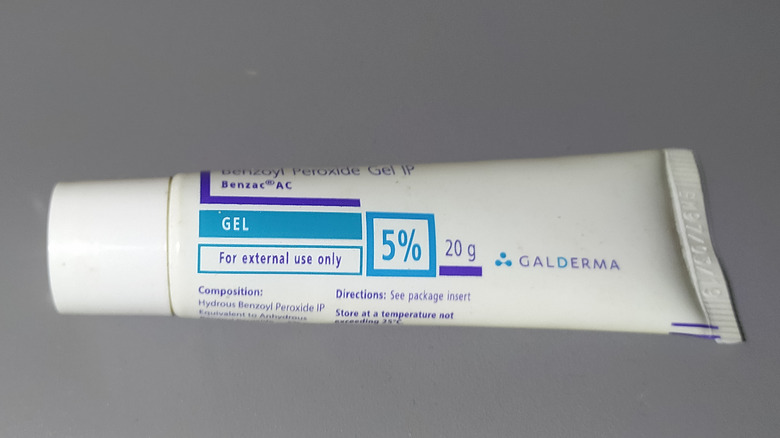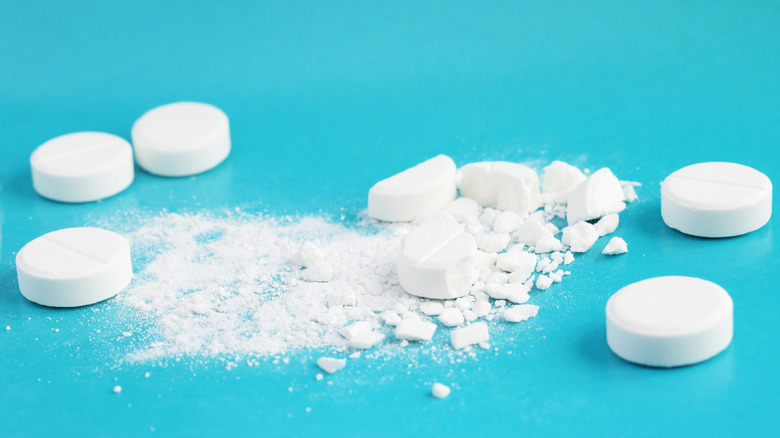Should You Really Be Using Toothpaste To Get Rid Of Pimples?
Like millions of teenagers and adults across the world, you've probably dealt with your fair share of breakouts. And as you stare at a new pimple in the mirror during your evening wash-up routine, you may recall hearing at some point that toothpaste "contains drying agents and antibacterial compounds," as Medical News Today puts it. But is this true?
In fact, many brands of toothpaste contain alcohol and hydrogen peroxide — both strong enough to decimate a pimple (via Healthline). Two more attributes may further tempt you to reach for the toothpaste tube on your bathroom counter. The first is that some brands include an ingredient called triclosan, which the U.S. Food and Drug Administration says can "reduce or prevent bacterial contamination." When you're trying to keep your face clean and healthy, this quality, too, sounds like a good thing, though the FDA says the ingredient's real value may be its ability to defeat gingivitis.
Then there could be menthol in the toothpaste, depending on your brand. As it reduces swelling, menthol tends to tingle. And this feeling, in turn, may make you tingle as you imagine that pimple making a swift exit. All you have to do is dab some toothpaste on your pimple and let it work its magic overnight. It's worth asking, though: are setting yourself up for a night of sweet, menthol-infused dreams or potential skin problems?
Many options await you
The answer comes from Medical News Today, which reports that toothpaste's ingredients "may have more risks than benefits when it comes to skincare." These ingredients include some you may have heard of before, such as calcium carbonate (also used as an antacid), glycerin, sodium bicarbonate (baking soda), and sodium lauryl sulfate (SLS). Individually or combined, these ingredients can irritate pimples and make them even redder and more pronounced (via Johns Hopkins All Children's Hospital).
As easy as it might be to overwhelm pimples with toothpaste, skin experts agree that it's better to use products that are formulated to treat pimples and consign toothpaste to treat your teeth. Toothpaste can be too strong on the skin, leaving it red and irritated. Besides, there are an array of over-the-counter and prescription facial treatments as well as natural remedies better suited to eliminating pimples.
Most over-the-counter cleansers, creams, gels, and ointments that target mild-to-moderate breakouts contain one or more of the following ingredients: alpha hydroxy, benzoyl peroxide (the most common), charcoal, salicylic acid, and sulfur (via Medical News Today). Repeated applications of such OTC products may be necessary, which is one reason people seek out stronger prescription acne treatments. Some of the more common include oral isotretinoin, oral minocycline, and topical tretinoin. Alternatively, oral antibiotics or birth control pills may overwhelm facial breakouts, too.
Mix your own remedy
Somewhere along the way, people often grow curious about natural remedies for pimples. You may, too, but it's smart to keep your expectations in check. Of some common natural remedies, Medical News Today notes that tea tree oil may be the best at foiling facial bacteria and soothing irritated skin. Aloe vera, prebiotics, and probiotics show mixed results.
Alternatively, try mixing your own pimple-be-gone remedy. Begin by washing your face with a gentle cleanser and patting it dry. Then crush an aspirin in a small bowl and add water until it turns into a paste after a good stir. Apply the paste to your pimple and let it dry — and literally dry out. If you open your medicine cabinet and find calamine lotion but no aspirin, you're in luck: applying a dab of the lotion to the pimple could make it disappear in a hurry, too (via Medical News Today).
Although acne spot dots are not a homemade solution, they can get down to business quickly. Often called healing dots that are treated with salicylic acid, these dots resemble tiny patches or bandages. Brands differ, and you should read the instructions beforehand, but most dots are left on the skin for at least six hours. That's probably as long as you heard toothpaste should remain on the skin. But this remedy, like the others, is one that has some bite — and a bite that won't leave its mark behind.


